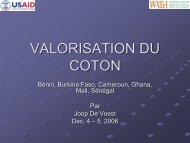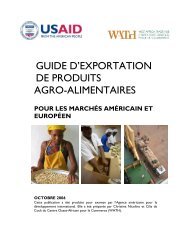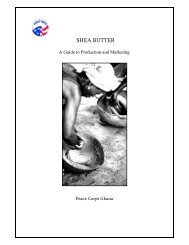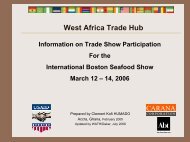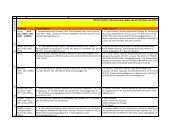A Brief Introduction to Textile Processing - AGOA Export Toolkit
A Brief Introduction to Textile Processing - AGOA Export Toolkit
A Brief Introduction to Textile Processing - AGOA Export Toolkit
You also want an ePaper? Increase the reach of your titles
YUMPU automatically turns print PDFs into web optimized ePapers that Google loves.
Traditional fly shuttle looms can produce only simple weaves (though 8 - shaft looms can produce<br />
much more complex patterns or weaves than 4 - or even 6 – shaft looms). A fly shuttle loom is one<br />
in which a wooden object (the shuttle) traverses (or “flies” across the warp yarns) <strong>to</strong> place the weft<br />
yarn. Other more modern looms include rapier looms in which a rapier, or metal band carries the yarn<br />
across, then cuts the yarn and retracts leaving the yarn<br />
in place, air jet or water jet looms, in which a burst or<br />
jet of air or water carries the weft yarn across the warp<br />
yarns. Jacquard looms are the most complex, using<br />
individual heddles <strong>to</strong> raise and lower each individual<br />
warp yarn, rather than the broad shafts used on other<br />
types of looms. Being able <strong>to</strong> independently raise and<br />
lower each warp yarn allows infinite flexibility in design,<br />
enabling weavers <strong>to</strong> create fabrics with very complex<br />
patterns. Jacquard fabrics, however, are also generally<br />
expensive relative <strong>to</strong> other types of fabrics. They are<br />
most often used for upholstery fabrics. In apparel, they<br />
may be used for coats or jackets. Above: “weaving room” full of fly shuttle<br />
looms<br />
Because<br />
of the perpendicular orientation of the warp and weft yarns, woven fabrics have good<br />
dimensional stability (unless very loosely woven) meaning they will not curl or twist in the way knit<br />
fabrics tend. However, they have no inherent stretch, unless made using yarns of stretch fiber such as<br />
lycra.<br />
K nit fabric manufacturing<br />
Just<br />
as there are different types of knit fabrics (warp and weft knits), there are several different<br />
designs of knitting machines. The type of machine used for a particular product is generally<br />
determined by the type of good <strong>to</strong> be produced. For example circular knitting machines are used for<br />
producing socks, hosiery, some intimate apparel, and the body of a t-shirt, in short, products that are<br />
tube-like in their finished form. Flat knitting machines (like rachel or racheltronic) are generally used for<br />
fabrics that are <strong>to</strong> be cut and sewn, and for laces.<br />
In knitting, yarn may be fed in<strong>to</strong> the knitting machine directly from cones racked in a creel, or yarn<br />
may be first wound on<strong>to</strong> a warp beam (as in weaving). For yarn fed directly from the cones in<strong>to</strong> the<br />
knitting machine, the shape of a creel is particular <strong>to</strong> the kind of cloth, the type of yarn, and the<br />
tensions needed <strong>to</strong> produce the goods. Spandex or other specialty yarns are typically wound on<strong>to</strong><br />
beams before being fed in<strong>to</strong> the knitting machine.<br />
F abric processing<br />
Desizing<br />
and bleaching. Fabric, when it comes off the loom or the knitting machine before it<br />
undergoes any additional processing, is called greige fabric (pronounced “gray,” like the color).<br />
Typically this fabric is a natural off-white color (as in the case of cot<strong>to</strong>n, silk, or many wool fabrics),<br />
or bright white (as is the case in many synthetic fabrics). To be suitable for use in apparel<br />
manufacturing, greige fabric needs additional treatment.<br />
Generally<br />
the next steps for greige fabric are desizing and bleaching. These prepare the fabrics for<br />
dyeing, printing, and / or finishing. (Because yarns used for knitting are not sized prior <strong>to</strong> use, no<br />
desizing step is necessary for knit fabrics. Desizing is simply the washing off of the starches or<br />
Prepared by Margaret Bishop and Brent Smith for the West Africa Trade Hub 8/04 9



